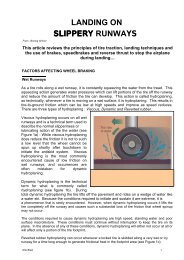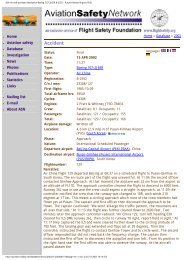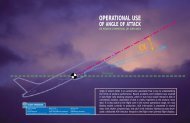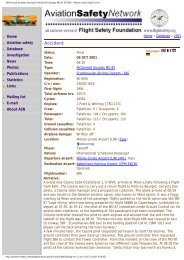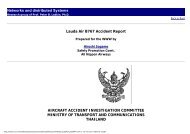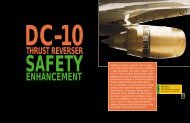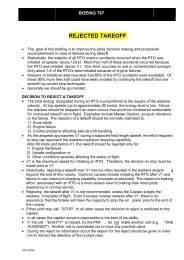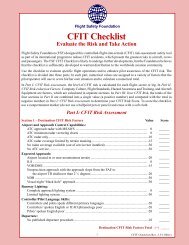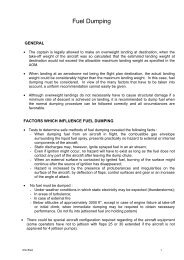Boeing 737-236 series 1, G-BGJL: Main document - Leonardo
Boeing 737-236 series 1, G-BGJL: Main document - Leonardo
Boeing 737-236 series 1, G-BGJL: Main document - Leonardo
Create successful ePaper yourself
Turn your PDF publications into a flip-book with our unique Google optimized e-Paper software.
the overwing exits, using child lap straps provided by the cabin crew.The two aisle seats of row 11<br />
(11C,11D) were left empty.<br />
The purser and the No 4 stewardess working in the forward partof the aircraft strapped themselves<br />
into their seats, each with a full harness. They were sitting on a stowable bench seat inthe left<br />
forward galley with their backs to the forward bulkhead,facing rearwards. Stewardess No 4 was in<br />
the outboard position adjacent to the left front (L1) door and the purser was in the inboard position<br />
nearer the centre of the galley and the cabin aisle; both were forward of a galley bulkhead resulting<br />
in a restricted view of the cabin. It is assumed that stewardesses Nos 2 and 3were occupying the<br />
crew seats in the rear galley, also on the left side of the aircraft, but facing forward with an<br />
unobstructed view of the passenger cabin ( Appendix 3 Fig a).<br />
The aircraft was cleared to line up on runway 24, and as fullnose-wheel steering was available only<br />
through a tiller on the left (commander's) side of the flight deck, the co-pilot assumed control after<br />
the commander had lined the aircraft up on the runway. Limited nosewheel steering is available<br />
through the commander's and co-pilot's rudder pedals. The aircraft was then cleared for take-off at<br />
0612 hrs with the wind reported as 250° at 7kt (para. 1.7), and the co-pilot requested take-off<br />
power. Thecommander advanced the throttles and commented that the No 1 engine acceleration was<br />
acceptable - the first officer agreed that it was better than on the previous day, the auto throttle was<br />
selected and the engines achieved the required take-off power. During the take-off run the<br />
commander made the routine call of "eightyknots" which was confirmed by the co-pilot, and 12<br />
seconds later a 'thump' or 'thud' was heard.<br />
Immediately, the commander ordered "stop", closed the throttles and selected reverse thrust on both<br />
engines. He then checked that the speed brakes (spoilers) were extended. The maximumIndicated<br />
Air Speed (IAS) achieved was 126 kt. The commander thought that they had suffered a tyre burst or<br />
a bird strike.<br />
Both reverser systems deployed and the right Engine Pressure Ratio(EPR ) peaked briefly at 1.32<br />
before settling at 1.25 for approximately5 seconds, after which reverse was de-selected on both<br />
enginesat a speed of about 70 kt; only the right engine reverser buckets retracted. The left engine<br />
EPR fell to zero within 2 seconds of the 'thud', and it remained at zero thereafter. The left<br />
engine high pressure spool speed (N2) decayed more gradually, with the result that the reverser<br />
buckets on the left engine were ableto deploy fully. However, by the time reverse was deselectedthe<br />
N2 had decayed to the point where falling engine oil pressure inhibited the reverser<br />
operating system, locking-out the left engine system with the buckets fully extended.<br />
The co-pilot had applied maximum wheel braking, however, because the commander considered a<br />
possible cause of the 'thud' to be tyre failure, and as there was considerable runway remaining<br />
ahead of the aircraft, he said "Don't hammer the brakes, don't hammer the brakes." The co-pilot<br />
responded by modulating the braking effort. At 45 seconds after the start of the take-offrun, 9<br />
seconds after the 'thud', as the aircraft decelerated through 85 kt groundspeed the commander started<br />
to inform Air TrafficControl (ATC) by a Radio Telephone (RTF) call that they were abandoning the<br />
take-off. The fire bell on the flight deck started ringing almost coincident with the start of this<br />
transmission and he added as he cancelled reverse thrust, "it looks as though we've got a fire on<br />
number 1". Following a 3 second pause, 19 seconds after the 'thud' and before the crew had<br />
inhibited the fire bell, ATC transmitted, "right there's a lot of fire, they're on their way now."<br />
Coincident with the end of this transmissionthe fire bell was inhibited and as the ground speed<br />
reduced below50 kt the commander queried with ATC whether he needed to evacuate the<br />
passengers. The controller replied "I would do via the starboard side." This message was passed 25



